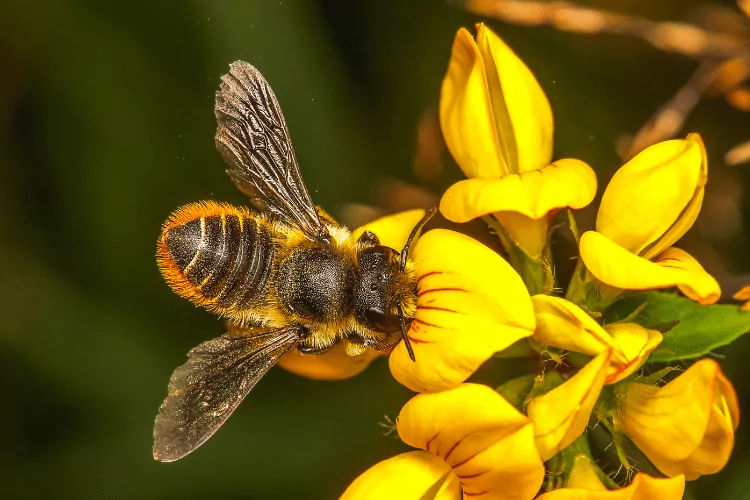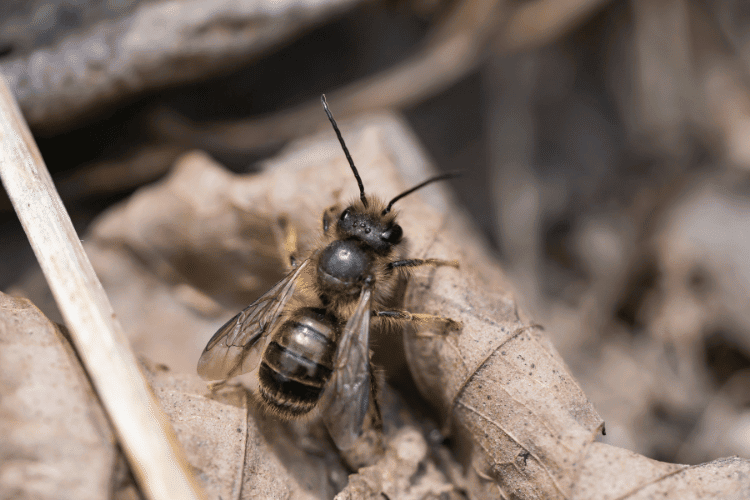Two of the easiest types of bees to take care of are leafcutter bees and mason bees. While most bees live in colonies, relying on their queen, these two bees are solitary!
So, what’s the difference between leafcutter vs. mason bees?
The main distinction between these bees is their nesting material. Mason bees and leafcutter bees both live in hollow, woody spaces. Yet, mason bees fill their nests with mud, and leafcutter bees use shredded leaves.
In this article, we’ll tell you everything you need to know about the two excellent pollinator bees. Let’s dive in!
Leaf Cutter Bees
Spotting leafcutter bees in your garden is pretty easy. They’re the same size as honey bees, but more slender, with a triangular abdomen that ends in a point.
Leafcutter bees have the signature black and yellow bands in their tail area, as well as long antennae.
The reason behind the name leafcutter bees is simple! These bees shred leaves into neat circular pieces. Then, they use the cuttings to build their nests.
Instead of traditional bee houses, leafcutter bees make their nests in wood cavities and hollow plants. They might also use old bee nests or holes in the ground.
Since leafcutter bees are solitary, they don’t colonize in their nest. Instead, the nests are mainly for reproducing. The female bee folds the leaf cuttings into cigar-like cells. Each cell contains a ball of pollen and a single egg.
Accordingly, leafcutter bees can pry into your plants, forming their nests. Additionally, they’ll also damage your precious foliage.

To prevent unwanted leafcutter bees from making a home out of your garden, you can cover susceptible plants with cheesecloth during late summer. Furthermore, seal any exposed pith to keep the bees from tunneling into them.
Raising Leaf Cutter Bees
Raising leafcutter bees can be pretty beneficial when it comes to pollination. Studies show that one Alfalfa leafcutter bee can do the same job as 20 honey bees!
These effective pollinators feed on pollen and nectar from flowers. As they scramble for food all over the flower they land on, pollen gets stuck on the bee’s abdomen hair. Then, the pollen scatters when the bee flies away.
To raise leafcutter bees, you can lure the bees into cavities in plants or by creating a nest. If you live in an area without many leafcutter bees, you can simply buy the cocoons.
Prepare the bee nest by lining your bee house with nesting materials. Then, fill the nests with the cocoons. Make sure the bee house is well-protected against parasitic wasps!
Mason Bees
Mason bees are some of the most unique-looking bees out there. Instead of the black and yellow bands and fuzz, Mason bees’ bodies are iridescent.
Their shiny bodies gleam in blue, green, and black. They have round bodies covered with numerous hairs. These hairs are what makes mason bees such productive pollinators.
Like leafcutter bees, mason bees are solitary. The female bee can make a nest out of almost anything. It can even live in holes in the ground!
Luckily, they don’t shred your plants. The nesting material that mason bees use is quite interesting too.
Mason bees use dirt and mud to fill their nests, preparing to fill them with cocoons. So, you can typically find the bee house close to the ground.
You can easily prevent unwanted mason bees from living in your garden as well. All you need to do is fill any holes in your wood and seal any plant pith.
Additionally, prevent the mason bees from finding nesting material by keeping your garden moist. You can also cover any bare spots with grass or mulch.
Raising Mason Bees
You can start raising mason bees even if you’re a beginner beekeeper. The beneficial pollinators make an excellent addition to any garden.
Not only are mason bees gorgeous, but they’re also helpful for your flowers and vegetables. That’s because these bees have a lot of tiny hair on their abdomen, and they scout mainly for pollen.

Therefore, when the bees are feeding on pollen, it gets stuck on their abdomen. Afterward, they can spread the pollen all over your garden.
You can make a home for your mason bee cocoons out of almost anything, from bee houses to hollow wood. Though, you can’t go wrong with cardboard tubes.
Differences Between Leaf Cutter vs. Mason Bees
Leafcutter bees and mason bees might seem significantly similar. However, here are the key distinctions that set them apart:
Appearance
Naturally, since both bees are splendid pollinators, and require similar housing, choosing one might come down to the way they look!
While leafcutter and mason bees are closely related, they look extremely unalike. For starters, leafcutter bees look more like traditional bees because of their black and yellow bands.
On the other hand, mason bees are iridescent. Though they glisten beautifully in the sun, you might even confuse them for flies!
Nesting Habits
Both mason bees and leafcutter bees make their homes out of old nests or wood cavities. They’re also solitary bugs, with the female building the nest only to reproduce.
The main difference between female mason bees and female leafcutter bees is the nesting material they use to build their homes.
As their name suggests, leafcutter bees use pieces of leaves, while mason bees fill the nesting holes with mud.
Care
Leafcutter and mason bees are beginner-friendly. You don’t need to plant any special vegetables, provide nectar, or collect honey!
The two bee types just collect pollen and even leave enough food in the cells for the cocoons. Other than providing a safe nest, you don’t need to do anything.
That said, it’s important to understand that leafcutter bees will shred your foliage, even if they have a suitable home.
Usually, this isn’t enough to damage most plants, but the patterns left by the bees can be an eyesore.
Conclusion
Comparing leafcutter vs. mason bees is pretty tricky. The two types of bees are solitary pollinators that are relatively low-maintenance.
The difference between these bees is in the name! Leafcutter bees use shredded leaves to make their home, while mason bees use dirt and mud.
The two bees couldn’t look more different too. Leafcutter bees have long, slender abdomens, with yellow and black stripes. In contrast, mason bees are round, glimmering in blue, green, or black.
- Does Bleach Kill Bees? - April 23, 2024
- How Do I Get Rid of Ants Without Harming Bees? - April 16, 2024
- Do Bug Zappers Kill Bees? Completely Explained - April 9, 2024
